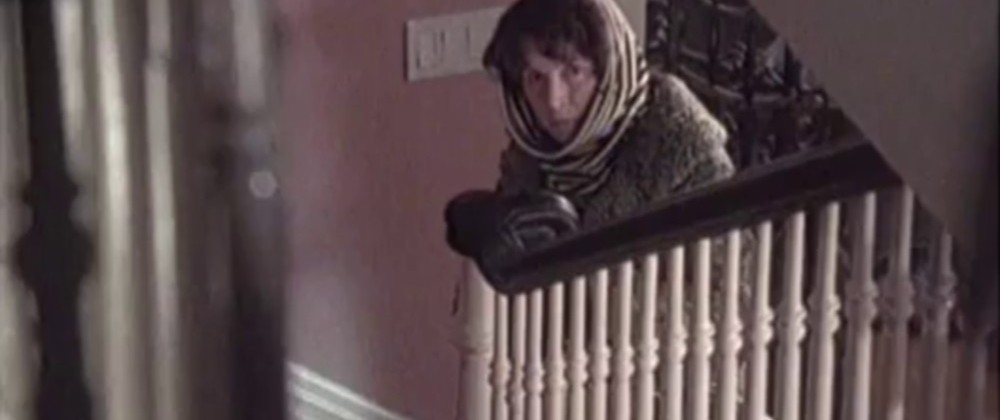Winter Lily

First-time (feature) director Roshell Bissett’s Winter Lily is best described as a claustrophobic horror film with a hint of dark humor and just enough of the macabre to keep an audience unsettled. The low-budget ($300,000), 35mm blow-up film uses a wintry Quebec landscape, disguised as New England, to underscore the type of physical and emotional isolation that can cause people to do strange things. A young photographer named Clive (Danny Gilmore) stops at a desolate bed and breakfast named Memory Lane, run by a peculiar lady named Agatha (Dorothée Berryman). Except for Agatha and her seemingly bed-ridden daughter Lily (Kimberly Laferrière), Clive is the only occupant at Memory Lane. When Clive comes across Lily’s diary he is drawn into her deepest thoughts. At this point the film follows a non-linear narrative structure, shifting between Clive’s subjectively rendered visual imaginings of the diary events, and the increasingly dark mystery surrounding Lily’s past. We begin to wonder, are these really Lily’s thoughts, or perhaps Clive’s? Is Lily still alive or is she merely a manifestation of Agatha’s arrested state of denial (Norma Bates?)? And if Lily is alive only as a mental projection, why has Clive become so romantically interested in her? And what are we to make of the shadowy father figure Grant (J.P. Bergeron)?
Bissett goes to great aesthetic design to hint at answers, but ultimately prefers to leave things open. For example, near the beginning when Clive is in the woods taking photographs we get an unclaimed subjective point of view shot looking at him through the trees, accompanied by a girl’s voice (Lily’s?). I asked Bissett, is Clive imagining this, is the voice real, or is Lily a ghost? She notes, “That is what is so interesting about making these kinds of films, because you can play on both. I don’t really like to say that it was a ghost or his imagination. I love these kinds of films because of that, simply because I get so caught up, like in Rosemary’s Baby. Is she really possessed by the devil or is she going crazy? Even at the end you don’t really know, even though you have that revelation scene, because of the way it is shot. Her confusion is so linked to the pregnancy, to the hormones, that you cannot be sure. And I like that ambiguity.”
Bissett elaborates on her attraction to Polanski, and other films that influenced Winter Lily. “I love Roman Polanski. Not that I achieved a Polanski film! Before shooting we also watched Misery and The Shining, for the use of the interior house and the sense of isolation. Plus I watched all of Polanski’s films again, for the suspense and the way he uses interior spaces. I think houses become so important in horror films, the architecture of horror if you will. So I was trying to figure out ways in which to shoot in this house and in the forest to create this isolation.”
The film’s best set piece makes great use of this ‘architectural horror.’ Through Agatha’s machinations, Clive wakes up to find himself on a conjugal bed, lying next to a lifeless Lily dressed in virginal white. Clive is framed in the extreme right foreground, sitting on the bed facing away from Lily, who is visible in the left background. As the stunned Clive contemplates his carnal desire, we catch a glimpse of Lily opening her eyes and turning her gaze toward Clive. It is a wonderful moment where, perhaps in Clive’s mind, he has willed Lily to life. What follows is an ambiguous love scene which cuts between shots where Lily actively participates in the sex (fantasy) and shots where she lies comatose (reality). I asked Bissett what her intentions were in this subtly coded necrophilia scene: “I did not want to intellectualize it too much. It is a rotting, dead body, pretty brutal, so I wanted to put that back in. I really like the idea of creating two emotions at the same time, like attraction and repulsion, that is really what that whole scene was about. Clive is creating this fantasy, but whenever someone is in a state of denial, or fantasy, there is still some part of them grounded in reality. I am really interested in psychology, and how we are sometimes drawn into these states of danger or repulsion. The way we are attracted and get that totally ambiguous feeling at the same time. That is the state I was trying to create.”
With regards to the film’s psychological horror, Bissett makes the following interesting observation: “I don’t know why, but somehow the women in the project really related to the psychology of this family, the isolation, and all the weird dynamics. Of course it is pushed to the extreme but it seemed to trigger something in myself, Dorothée, and Kimberly. I think it was a little bit more difficult for Danny to understand his role. He was a little confused as to what was going on. But Dorothée got right into it, she understood the isolation.”
Bissett holds off on any visceral violence until the conclusion, where characters die in traditional slasher film fashion. Distraught, and perhaps suicidal, Clive jumps out of the attic window onto the snow-filled ground. A shot of Clive’s motionless body is included in a montage of overhead views of all the dead bodies. But Bissett maintains a sense of irony throughout the violent denouement: “Those overhead shots which are visually interesting are also sarcastic, like a body count at the end of a horror film. But it relates to this idea of whether Clive is dead. Is he going to become just another of these dead bodies? I have an opinion about people who walk around life in a state of denial, and not dealing with their unconscious or projecting it. For me that is really what this film is about. Clive having to wake up and face what life is all about.”










